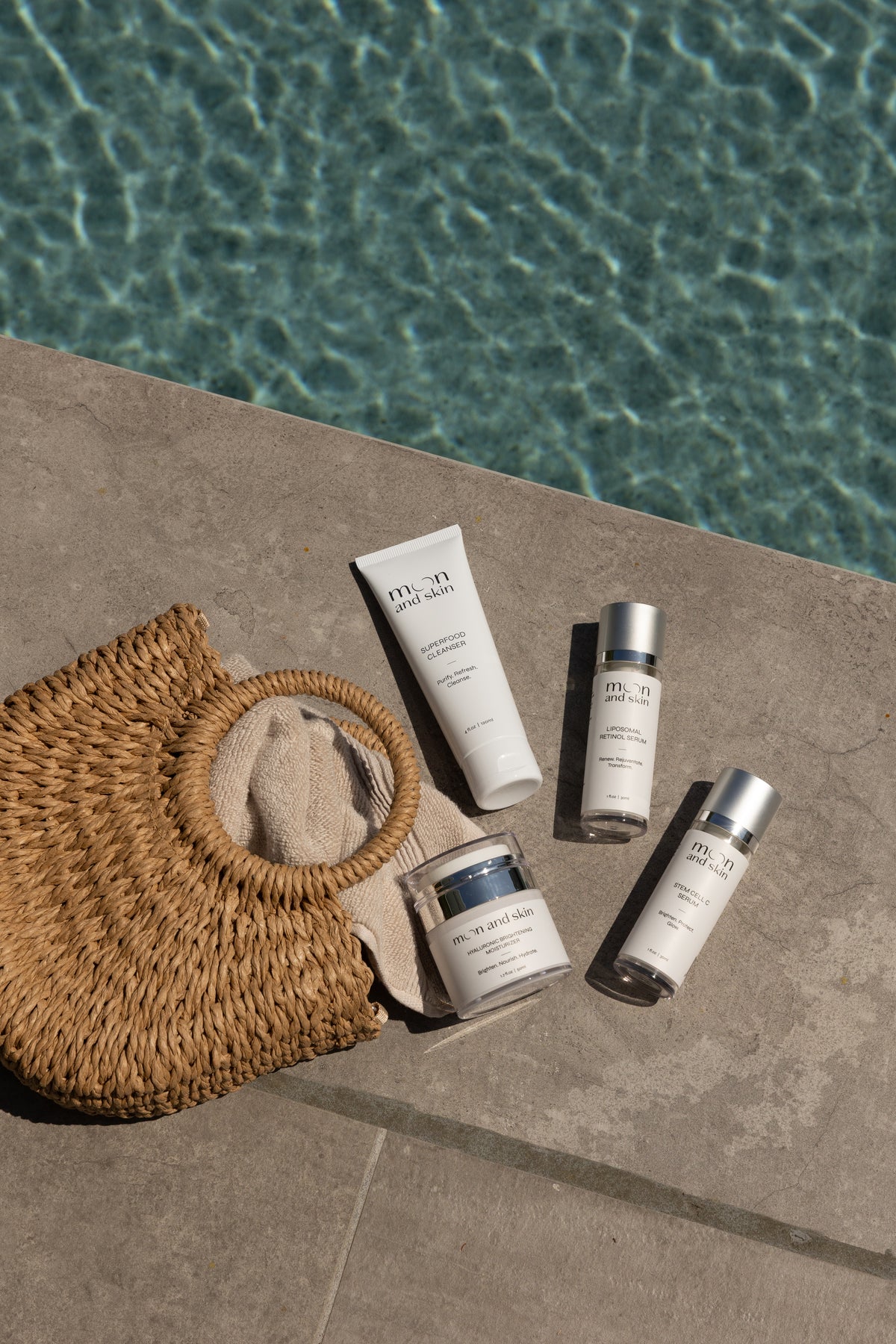Table of Contents
Introduction
Have you ever wondered why some people seem to have effortlessly glowing skin while you’re struggling with breakouts or dryness? It may not just be genetics; it could be the skincare routine they follow. A well-structured skincare routine is essential for maintaining skin health, addressing specific concerns, and achieving that radiant glow we all desire.
According to the American Academy of Dermatology, a consistent skincare routine can enhance your complexion and contribute to long-term skin health. In a world filled with countless products and conflicting advice, knowing what to include in your skincare routine can feel overwhelming. We understand that navigating this landscape can be confusing, and that’s why we’re here to break it down.
In this blog post, we’ll explore what a skincare routine should include, from cleansing to moisturizing, and everything in between. We’ll also introduce you to some of our favorite products from Moon and Skin, designed to support your skin through every phase of life.
Together, let’s embark on a journey to discover the essential components of an effective skincare routine that not only enhances your appearance but also empowers you to feel confident in your skin.
The Key Components of a Skincare Routine
Building an effective skincare routine involves several key steps, each serving a specific purpose. Here’s a breakdown of what your routine should include:
1. Cleanser
Cleansing is the foundation of any skincare routine. It removes dirt, oil, makeup, and impurities that accumulate on your skin throughout the day. A good cleanser prepares your skin for subsequent products, making them more effective.
Choosing the Right Cleanser:
- For Oily Skin: Look for gel-based or foaming cleansers that can help control excess oil. Ingredients like salicylic acid can be beneficial.
- For Dry Skin: Cream or oil-based cleansers are best as they hydrate while cleansing.
- For Sensitive Skin: Opt for fragrance-free, gentle cleansers that won’t irritate the skin.
At Moon and Skin, our Superfood Cleanser is formulated with HydroProtein Technology to provide a deep yet gentle cleanse, nourishing your skin while removing impurities.
Key Takeaway: Always cleanse your skin twice a day—once in the morning and once at night—to maintain a healthy complexion.
2. Toner
Toners help to balance your skin’s pH levels after cleansing, hydrate, and prepare your skin to absorb the next steps in your routine.
Types of Toners:
- Hydrating Toners: These contain ingredients like hyaluronic acid and are ideal for dry skin.
- Exfoliating Toners: Often containing AHAs or BHAs, these help to remove dead skin cells and unclog pores, suitable for oily or acne-prone skin.
While toning is an optional step for some, it can enhance the effectiveness of your routine.
Key Takeaway: Incorporating a toner can help your skin better absorb serums and moisturizers.
3. Exfoliation
Exfoliating helps to remove dead skin cells, promoting cell turnover and preventing clogged pores. This step is crucial for achieving smoother, brighter skin.
Types of Exfoliation:
- Physical Exfoliants: These include scrubs with granules that manually slough off dead skin.
- Chemical Exfoliants: Products containing AHAs or BHAs that dissolve dead skin cells without the need for scrubbing.
For most skin types, exfoliating once or twice a week is sufficient. However, those with sensitive skin should opt for milder products to avoid irritation.
Key Takeaway: Regular exfoliation can enhance skin texture and radiance.
4. Treatments (Serums)
Serums are concentrated formulas designed to target specific skin concerns, such as fine lines, dark spots, or acne. They are usually lightweight and packed with active ingredients.
Choosing the Right Serum:
- Vitamin C Serum: Great for brightening and protecting against environmental damage. Our Stem Cell C Serum utilizes advanced plant-cell technology to brighten, hydrate, and protect your skin.
- Retinol Serum: Ideal for anti-aging and improving skin texture. Our Liposomal Retinol Serum delivers maximum results with minimal irritation, making it suitable for various skin types.
Key Takeaway: Select serums based on your specific skin concerns, and apply them after toning for the best results.
5. Moisturizer
Moisturizing is a crucial step to hydrate and lock in moisture, creating a protective barrier on your skin.
Choosing the Right Moisturizer:
- For Oily Skin: Lightweight, oil-free gel moisturizers can hydrate without adding excess oil.
- For Dry Skin: Cream-based moisturizers rich in hydrating ingredients like glycerin or hyaluronic acid are essential.
- For Combination Skin: A balanced moisturizer that hydrates without overloading any specific area of your face is ideal.
Our Hyaluronic Brightening Moisturizer is an acne-safe formula designed to deeply hydrate and brighten the skin.
Key Takeaway: Always moisturize to maintain hydration and protect your skin barrier.
6. Eye Care
The skin around the eyes is delicate and requires special attention. Using an eye cream can help target concerns like puffiness, dark circles, and fine lines.
Choosing the Right Eye Cream: Look for eye creams with ingredients like caffeine to reduce puffiness, peptides for firmness, and antioxidants for protection.
Key Takeaway: Regularly applying eye cream can help maintain the health and appearance of the delicate eye area.
7. Sunscreen
Sunscreen is perhaps the most crucial step in your morning routine. Protecting your skin from harmful UV rays is essential for preventing premature aging and skin cancer.
Choosing the Right Sunscreen:
- Broad-Spectrum: Ensure it protects against both UVA and UVB rays.
- SPF 30 or Higher: This is the minimum recommended protection level.
Key Takeaway: Apply sunscreen daily, even on cloudy days, to protect your skin from damage.
Tailoring Your Routine to Your Skin Type
Understanding your skin type is essential for selecting the right products and creating an effective routine. Here’s a quick overview of the main skin types:
1. Normal Skin
Normal skin is well-balanced, with no extreme dryness or oiliness. It can benefit from a standard routine that includes all the key components.
2. Oily Skin
Oily skin produces excess sebum, leading to shine and potential breakouts. Focus on lightweight, oil-free products and regular exfoliation.
3. Dry Skin
Dry skin lacks moisture and can feel tight or flaky. Hydrating cleansers, rich moisturizers, and gentle exfoliation are essential.
4. Combination Skin
Combination skin features both oily and dry areas. Tailor your routine by using different products for different areas of your face.
5. Sensitive Skin
Sensitive skin can react to various products and environmental factors. Opt for gentle, fragrance-free products and patch-test new items.
Building Your Complete Skincare Routine
Creating a skincare routine doesn’t have to be complicated. Here’s a simple outline to get you started:
Morning Routine:
- Cleanser: Use a gentle cleanser to start your day.
- Toner: Apply a hydrating toner for added moisture.
- Serum: Choose a vitamin C serum for brightness and protection.
- Eye Cream: Apply a lightweight eye cream to address puffiness.
- Moisturizer: Use a suitable moisturizer for your skin type.
- Sunscreen: Finish with a broad-spectrum sunscreen.
Evening Routine:
- Cleanser: Double cleanse if you’ve worn makeup.
- Toner: Use a hydrating or exfoliating toner as needed.
- Treatment: Apply targeted treatments like retinol or acne serum.
- Eye Cream: Reapply eye cream to nourish overnight.
- Moisturizer: Use a richer moisturizer or night cream if desired.
Conclusion
Establishing a skincare routine tailored to your unique skin type and concerns is key to achieving healthy, radiant skin. By incorporating essential components such as cleansing, toning, treating, moisturizing, and protecting, you can create a regimen that not only enhances your appearance but also empowers you to feel confident in your skin.
At Moon and Skin, we’re committed to providing clean, thoughtful skincare products that support you through every phase of life. To help you build a complete routine, consider our Bundle & Save Collection for an all-in-one solution that offers value and effectiveness.
Your journey to healthier skin starts here. Let’s make informed skincare choices together!
FAQ
1. How often should I exfoliate? Exfoliating once or twice a week is generally sufficient for most skin types, but adjust based on your skin’s sensitivity.
2. Can I skip toner? While toner is optional, it can enhance your routine by providing extra hydration and preparing your skin for serums.
3. What if I have multiple skin concerns? You can tailor your routine by using different products for different areas of your face, focusing on specific concerns as needed.
4. Is it necessary to use sunscreen every day? Absolutely! Daily sunscreen use is crucial for protecting your skin from UV damage, regardless of the weather.
5. How long will it take to see results from my skincare routine? Consistency is key. It may take several weeks to notice significant improvements, so stick with your routine for the best results.







